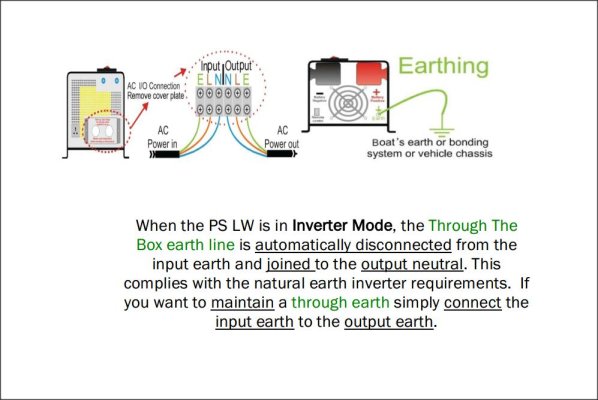Interesting information from the manual posted.
I really don't see a lot of issues with what they say, and I think my first impression would be to think that what they have is basically not bad.
In shore power operating they have the shore power ground fed through the box to the output ground and not bonded to the neutral so that is all fine. The question of whether or not this is safe in relation to the the chassis being grounded or not to the shore ground should not be an issue because the ground buss bar in the main box will be grounded to the chassis. There would be continuous ground from the chassis to the shore power pole. The neutral and ground would not be bonded in the van unless the extra wire to the breaker box was in place, which is still odd at this point.
When the shore power is disconnected, the inverter disconnects the shore power ground feed through to the output ground and at the same time connects the output neutral and ground to bond them. This also looks to be fine as the inverter is ground and neutral bonded at the source and the chassis is still grounded to the ground wiring at the breaker panel. The only thing that isn't grounded is the shore power cord and that doesn't matter as it not connected to any power source or carrying any current.
My guess would be that they put the little wire jumping the grounds on so that a GFCI or other item wouldn't see an open ground on the cord while for the instant when plugging in and trip. Once plugged in the ground is complete. Using a big wire on it won't hurt anything, either, and in the Magnum drawing, that is how they did it, as they show the ground going through the box all the time. Of course, with the jumper on, you also stand the chance of a device seeing the neutral and ground connected and not liking that, so it goes both ways.
Personally, if I am looking at the setup correctly, and that is the right manual, I don't see a hazard with any of the scenarios. No jumper, small jumper, big jumper all would appear to be safe.
I really don't see a lot of issues with what they say, and I think my first impression would be to think that what they have is basically not bad.
In shore power operating they have the shore power ground fed through the box to the output ground and not bonded to the neutral so that is all fine. The question of whether or not this is safe in relation to the the chassis being grounded or not to the shore ground should not be an issue because the ground buss bar in the main box will be grounded to the chassis. There would be continuous ground from the chassis to the shore power pole. The neutral and ground would not be bonded in the van unless the extra wire to the breaker box was in place, which is still odd at this point.
When the shore power is disconnected, the inverter disconnects the shore power ground feed through to the output ground and at the same time connects the output neutral and ground to bond them. This also looks to be fine as the inverter is ground and neutral bonded at the source and the chassis is still grounded to the ground wiring at the breaker panel. The only thing that isn't grounded is the shore power cord and that doesn't matter as it not connected to any power source or carrying any current.
My guess would be that they put the little wire jumping the grounds on so that a GFCI or other item wouldn't see an open ground on the cord while for the instant when plugging in and trip. Once plugged in the ground is complete. Using a big wire on it won't hurt anything, either, and in the Magnum drawing, that is how they did it, as they show the ground going through the box all the time. Of course, with the jumper on, you also stand the chance of a device seeing the neutral and ground connected and not liking that, so it goes both ways.
Personally, if I am looking at the setup correctly, and that is the right manual, I don't see a hazard with any of the scenarios. No jumper, small jumper, big jumper all would appear to be safe.


